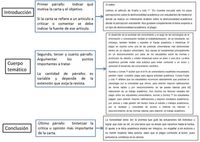Abstract
A letter to the editor is a scientific publication classified as a short communication. It allows readers to interact with authors through opinions, criticism, contributions, ideas, hypotheses, and new data. This article presents a literature review on the primary considerations for writing and preparing a letter to the editor. The authors explored articles from the PubMed, Scopus, and SciELO databases from 2010 (January) to date (December 2020). The letter to the editor as a scientific publication has specific writing and preparation features that may refer to an article published in the journal, a contextual topic, or a reader’s contribution. It allows the academic community to exchange opinions on the ideas published by the researchers. It has pedagogical value as it enables novel students and researchers to enter the world of scientific criticism and writing. It also helps them familiarize themselves with the editorial process of sending and publishing scientific papers.
References
Tang BL. Letter to the editor: On plurality and authorship in science. Account Res. 2018. [Acceso: 04/07/2020]; 25(4): 254-258. Disponible en: https://pubmed.ncbi.nlm.nih.gov/29587536/
Anthony R. From the Editor: What's a letter to the editor? J Occup Environ Hyg. 2019. [Acceso: 04/07/2020];16(1):D1-D2. Disponible en: https://pubmed.ncbi.nlm.nih.gov/30856088/
Falavarjani KG, Kashkouli MB, Chams H. Letter to Editor, a scientific forum for discussion. J Curr Ophthalmol. 2016. [Acceso: 04/07/2020];28(1):1-2. Disponible en: https://pubmed.ncbi.nlm.nih.gov/27239593/
Süer E, Yaman Ö. How to write an editorial letter? Turkish J Urol. 2013. [Acceso: 04/07/2020];39(Suppl 1):41-3. Disponible en: https://www.turkishjournalofurology.com/en/how-to-write-an-editorial-letter-13435
Dkhar SA. Letter to editor: its importance and drawbacks. Int J Community Med Public Health. 2018. [Acceso: 04/07/2020];5:4634-6. Disponible en: https://www.semanticscholar.org/paper/Letter-to-editor%3A-its-importance-and-drawbacks-Dkhar/f6c43031714b842a84f785c912e83a5d20d0d4d6
International Committee of Medical Journal Editors. Uniform requirements for manuscripts submitted to biomedical journals: publishing and editorial issues related to publication in biomedical journals: correspondence. [Acceso: 04/07/2020]. Disponible en: www.icmje.org/ publishing_5correspond.html.
Jadhav S, Bavdekar SB. Letter to Editor: Keeping the Dialogue Going. J Assoc Physicians India. 2015. [Acceso: 05/08/2020];63(5):55-57. Disponible en: https://pubmed.ncbi.nlm.nih.gov/26591146/
Anstey A. Letters to the editor: time for more scholarly debate. Br J Dermatol. 2014. [Acceso: 05/08/2020];171(1):1–2. Disponible en: https://onlinelibrary.wiley.com/doi/full/10.1111/bjd.13134
Why Write a Letter to the Editor?. Adv Neonatal Care. 2017. [Acceso: 05/08/2020];17(2):77-78. Disponible en: https://pubmed.ncbi.nlm.nih.gov/28362696/
López-Hernández D; Brito-Aranda L, Torres-Fonseca, A. Importancia y redacción de la carta al editor. Revista de Especialidades Médico Quirúrgicas. [Acceso: 05/08/2020]; 19(4): 475-478. Disponible en: https://www.medigraphic.com/cgi-bin/new/resumen.cgi?IDARTICULO=54588
Sosa-Gonzalo SL, Aveiro-Róbalo TR, Galán-Rodas E. Cartas al editor: Importancia y recomendaciones para su redacción. CIMEL. 2016. [Acceso: 05/08/2020]; 21(2): 48- 50. Disponible en: https://www.cimel.felsocem.net/index.php/CIMEL/article/view/643/361
Tierney E, O’Rourke C, Fenton JE. What is the role of 'the letter to the editor'? Eur Arch Otorhinolaryngol. 2015. [Acceso: 05/08/2020];272:2089. Disponible en: https://pubmed.ncbi.nlm.nih.gov/25231709/
Montenegro-Idrogo JJ, Mejía-Dolores JW, Chalco-Huamán JL. Cartas al editor publicadas en revistas biomédicas peruanas indizadas en SciELO- Perú 2006-2013. Rev Peru Med Exp Salud Publica. 2015. [Acceso: 05/08/2020];32(1):104–9. Disponible en: http://www.scielo.org.pe/scielo.php?script=sci_arttext&pid=S1726-46342015000100016
Revista de Investigación Clínica. Instrucciones a los autores. [Acceso: 05/08/2020]. Disponible en: http://www.scielo.org.mx/revistas/ric/einstruc.htm
Fernández-Esteve, García AM. Sr. Director: La importancia de las Cartas al Director. Gac Sanit. 2005. [Acceso: 05/08/2020];19(5):354-355. Disponible en: http://scielo.isciii.es/scielo.php?script=sci_arttext&pid=S0213-91112005000500002
Miyahira JM. Importancia de las Cartas al editor. Rev Med Hered. 2010. [Acceso: 08/08/2020];21:57-58.Disponible en: http://www.scielo.org.pe/scielo.php?script=sci_arttext&pid=S1018-130X2010000200001
Peh WC, Ng KH. Writing a letter to the Editor. Singapore Med J. 2010. [Acceso: 08/08/2020];51(7):532–5. Disponible en: https://pubmed.ncbi.nlm.nih.gov/20730391/
Gokani SA, Sharma E, Sharma T, Moudhgalya SV, Selvendran SS, Aggarwal N. Impact of a National Journal Club and Letter Writing Session on Improving Medical Students' Confidence with Critical Appraisal. Adv Med Educ Pract. 2019. [Acceso: 08/08/2020];10:1081-1087. Disponible en: https://pubmed.ncbi.nlm.nih.gov/31920419/
Miyahira JM. La investigación formativa y la formación para la investigación en el pregrado. Rev Med Hered. 2009. [Acceso: 08/08/2020];20(3):119-122. Disponible en: https://www.researchgate.net/publication/262442184_La_investigacion_formativa_y_la_formacion_para_la_investigacion_en_el_pregrado
Castro-Rodríguez Y. La lectura de artículos científicos. Entrevista a estudiantes del pregrado. Odontol. Sanmarquina. 2020. [Acceso: 08/08/2020]; 23(1): 93-95. Disponible en: https://revistasinvestigacion.unmsm.edu.pe/index.php/odont/article/view/17516
Caballero-Ortiz AG. Cartas al editor como oportunidad de primera publicación en los miembros de FELSOCEM. CIMEL. 2015. [Acceso: 08/08/2020]; 19(2). Disponible en: http://www.cimel.felsocem.net/index.php/CIMEL/article/viewArticle/494
Spodick DH, Goldberg RJ. The editor's correspondence: analysis of patterns appearing in selected specialty and general journals. Am J Cardiol. 1983 [Acceso: 20/02/2021]; 52: 1290- 1292. Disponible en: https://pubmed.ncbi.nlm.nih.gov/6650419/
Johnson C, Green B. How to write a letter to the editor: an author’s guide. J Chiropr Med. 2006. [Acceso: 08/08/2020];5(4):144–7. Disponible en: https://www.ncbi.nlm.nih.gov/pmc/articles/PMC2647072/
Kearney MH. Write to Me Please: The Scholarly Importance of Letters to the Editor. Res Nurs Health. 2015. [Acceso: 08/08/2020];38(5):327–9. Disponible en: https://pubmed.ncbi.nlm.nih.gov/26291520/
Sturpe D, Kolar C, Janke K. Enhancing scholarly dialogue: Inviting Letters to the Editor. Curr Pharm Teach Learn. 2016. [Acceso: 08/08/2020];8(3):269–70. Disponible en: https://pubmed.ncbi.nlm.nih.gov/30070234/
Clouet D. Cartas al Editor: Algo más que 1.000 palabras. Rev Med Chile. 2014. [Acceso: 08/08/2020]; 142: 677-678. Disponible en: https://scielo.conicyt.cl/scielo.php?script=sci_arttext&pid=S0034-98872014000500021
Brown CJ. Letters to the editor provide a forum for readers and help make a journal accountable to the medical fraternity. Can Med Assoc J. 1997; 157:792-4.
Moffatt B. Scientific authorship, pluralism, and practice. Account Res. 2018. [Acceso: 08/08/2020];25(4):199-211. Disponible en: https://pubmed.ncbi.nlm.nih.gov/29400074/
Neghina R, Neghina AM. How to build a scientific publishing career based on hundreds of letters-to-the-editor: ―The Art of Loss‖. Account Res. 2011. [Acceso: 08/08/2020];18(4):247–9. Disponible en: https://www.unboundmedicine.com/medline/citation/21707416/How_to_build_a_scientific_publishing_career_based_on_hundreds_of_letters_to_the_editor:_%22The_Art_of_Loss%22_

This work is licensed under a Creative Commons Attribution-NonCommercial 4.0 International License.
Copyright (c) 2021 Odontoestomatología


